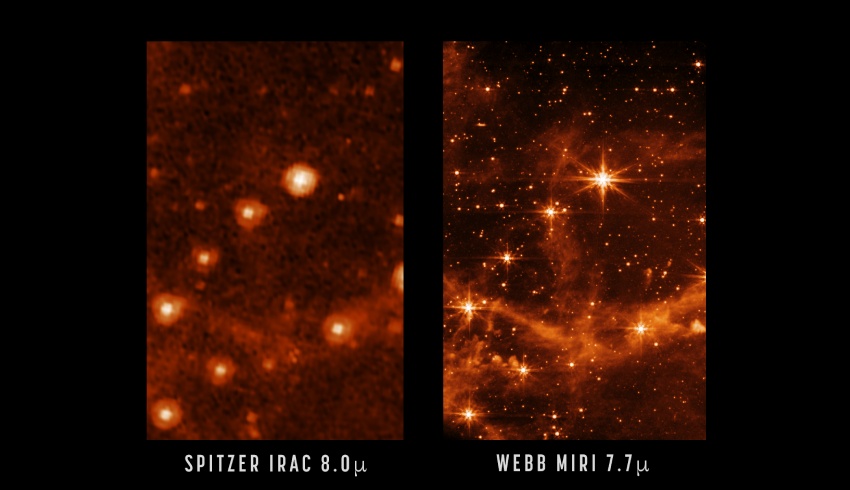
According to NASA, the US$10 billion telescope is currently undertaking its final tweaks before beginning operations, such as measuring the sharpness of its images and observing moving targets like comets and satellites.
In this latest image released, NASA compares Webbs’ glimpse of the Large Magellanic cloud – using the Mid-Infrared Instrument (MIRI) – beside a picture of the same satellite galaxy in the Milky Way, taken by the agency’s Spitzer Space Telescope’s Infrared Array Camera.

Launched in 2003 and concluding operations in 2020, Spitzer was one of NASA’s “Great Observatories”, and was the first telescope to provide high-resolution images of the near and mid-infrared universe.
But with a significantly larger primary mirror, 6.5 metres approximately, and improved detectors, Webb’s cameras can capture the infrared sky with “improved clarity”, NASA says.
MIRI will see light in the mid-infrared region of the electromagnetic spectrum in space, with wavelengths longer than our own eyes can see, and provide new details of distant galaxies and newly forming stars.
“This is a really nice science example of what Webb will do for us in the coming years,” Chris Evans, the telescope’s project scientist at the European Space Agency said during a livestream on Monday.
“We’ve done a lot of studies of star and planet formation in our own galaxy, but here we’re looking at it in the Magellanic Clouds, so small external galaxies, where they’re chemically less evolved than our own Milky Way," Evans added.
“So, this gives us a chance to look at the processes of star and planet formation ... in a very different environment to our own galaxy.”
NASA said the image shows the emission from “polycyclic aromatic hydrocarbons”, or molecules of carbon and hydrogen that “play an important role in the thermal balance and chemistry of interstellar gas”.
Evans added that while Spitzer achieved “amazing things”, the observatory was primarily used for wide-field surveys.
He said that Webb will provide “an amazing view of the processes in a different galaxy for the first time, cutting through the dust ... We’re using the mid-infrared to look through the material that otherwise would be obscured at visible wavelengths”.
The telescope launched on Christmas Day in 2021 and is currently in the final few months before being able to start its science experiments in the summer.
James Webb is a collaboration between NASA, the European Space Agency, the Canadian Space Agency and French launch provider Arianespace.
Its mission – dubbed VA256 – has been in the making for 14 years and it’s hoped Webb will be able to reveal what the universe looked like almost 14 billion years ago.

Isabella Richards
Bella Richards is a journalist who has written for several local newspapers, her university newspaper and a tech magazine, and completed her Bachelor of Communications (Journalism) at the University of Technology Sydney in 2020. She joined Momentum Media in 2021, and has since written breaking news stories across Space Connect, Australian Aviation and World of Aviation.
You can email Bella on: [email protected]
Receive the latest developments and updates on Australia’s space industry direct to your inbox. Subscribe today to Space Connect here.









